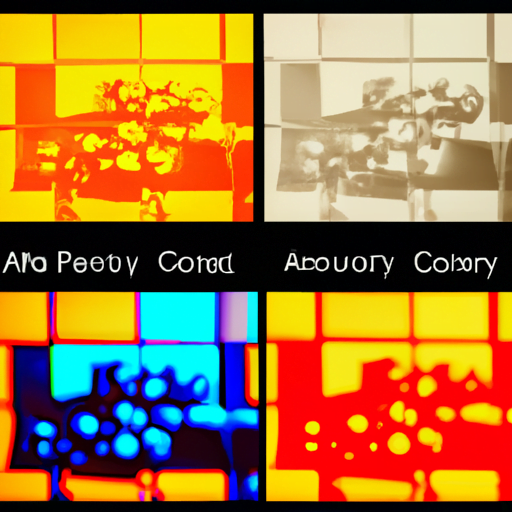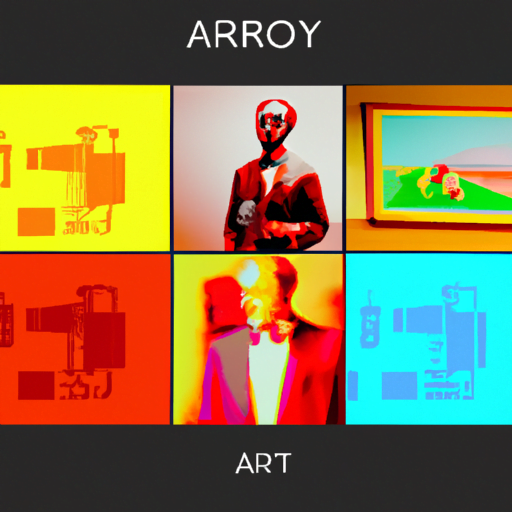
-
Table of Contents
- The Art and Science of AI-Enhanced Color Theory
- The Basics of Color Theory
- The Role of AI in Color Theory
- Color Analysis and Trends
- Color Recommendation Systems
- Case Studies: AI in Color Theory
- Adobe Sensei: AI-Powered Color Tools
- Pantone and AI: Color of the Year Prediction
- The Future of AI-Enhanced Color Theory
- Conclusion
The Art and Science of AI-Enhanced Color Theory

Color theory has long been a fundamental aspect of art and design. Artists and designers have relied on their understanding of color to create visually appealing compositions and evoke specific emotions. However, with the advent of artificial intelligence (AI), color theory has taken on a new dimension. AI algorithms can now analyze vast amounts of data to enhance color theory, providing valuable insights and opening up new possibilities for artists and designers. In this article, we will explore the intersection of art, science, and AI in the realm of color theory.
The Basics of Color Theory
Before delving into the advancements brought about by AI, it is essential to understand the basics of color theory. Color theory encompasses the principles and guidelines that govern the use of color in art and design. It explores how colors interact with each other and how they can be combined to create harmonious or contrasting compositions.
One of the fundamental concepts in color theory is the color wheel. The color wheel is a visual representation of the relationships between colors. It consists of primary colors (red, blue, and yellow), secondary colors (orange, green, and purple), and tertiary colors (created by mixing primary and secondary colors).
Another crucial aspect of color theory is color harmony. Color harmony refers to the pleasing combination of colors in a composition. Artists and designers use various techniques, such as complementary colors (colors opposite each other on the color wheel), analogous colors (colors adjacent to each other on the color wheel), and triadic colors (three colors equidistant from each other on the color wheel), to achieve color harmony.
The Role of AI in Color Theory
Artificial intelligence has revolutionized many industries, and color theory is no exception. AI algorithms can analyze vast amounts of data, including images, to extract valuable insights about color usage and preferences. This data-driven approach to color theory can provide artists and designers with a deeper understanding of color and help them make more informed decisions.
Color Analysis and Trends
AI algorithms can analyze large datasets of images to identify color trends and patterns. By examining the colors used in popular artworks, designs, and photographs, AI can identify emerging color trends and predict future color preferences. This information can be invaluable for artists and designers who want to stay ahead of the curve and create visually appealing compositions that resonate with their target audience.
For example, an AI analysis of fashion photography may reveal that pastel colors are gaining popularity. Armed with this knowledge, a fashion designer can incorporate pastel hues into their upcoming collection, increasing the chances of success in the market.
Color Recommendation Systems
AI algorithms can also be used to develop color recommendation systems. These systems analyze the context and purpose of a design project and suggest appropriate color palettes. By considering factors such as the target audience, brand identity, and emotional impact, AI can generate color palettes that align with the desired objectives.
For instance, a graphic designer working on a website for a children’s toy brand can use a color recommendation system to generate a palette that evokes a sense of playfulness and joy. The AI algorithm takes into account the brand’s identity and the preferences of the target audience, ensuring that the color choices resonate with the intended users.
Case Studies: AI in Color Theory
Several real-world examples demonstrate the power of AI in enhancing color theory. Let’s explore a few case studies that highlight the impact of AI on color-related applications.
Adobe Sensei: AI-Powered Color Tools
Adobe Sensei, the AI platform developed by Adobe, has introduced several AI-powered color tools that assist artists and designers in their creative process. One notable tool is the “Color Themes” feature in Adobe Photoshop, which uses AI algorithms to extract color palettes from images. Users can select an image, and the AI algorithm suggests a set of harmonious colors based on the image’s content.
This AI-powered tool saves artists and designers valuable time by automating the color selection process. It also provides inspiration and expands the creative possibilities by offering color combinations that may not have been considered otherwise.
Pantone and AI: Color of the Year Prediction
Pantone, the renowned color authority, has also embraced AI to predict the “Color of the Year.” Pantone’s “Color of the Year” is a highly anticipated announcement that influences various industries, including fashion, interior design, and graphic design.
By leveraging AI algorithms to analyze social media trends, consumer behavior, and cultural influences, Pantone can predict the color that will dominate the following year. This prediction helps designers and marketers align their creative efforts with the anticipated color trend, ensuring their work remains relevant and resonates with the target audience.
The Future of AI-Enhanced Color Theory
The integration of AI into color theory is still in its early stages, but the potential for growth and innovation is immense. As AI algorithms become more sophisticated and capable of understanding complex visual contexts, the applications of AI in color theory will continue to expand.
Here are some potential future developments in AI-enhanced color theory:
- Personalized Color Recommendations: AI algorithms could analyze an individual’s preferences, cultural background, and personality traits to generate personalized color recommendations. This level of personalization would allow artists and designers to create truly tailored compositions that resonate with each individual viewer.
- Real-Time Color Analysis: AI algorithms could analyze live video feeds or images in real-time to provide instant color analysis and recommendations. This would be particularly useful in fields such as fashion, where designers could receive immediate feedback on color choices during runway shows or photo shoots.
- Cross-Domain Color Analysis: AI algorithms could analyze color usage across different domains, such as art, fashion, and interior design, to identify cross-domain color trends and patterns. This broader perspective would enable artists and designers to draw inspiration from various fields and create innovative compositions.
Conclusion
The integration of AI into color theory has opened up new possibilities for artists and designers. By leveraging AI algorithms, artists and designers can gain valuable insights into color trends, receive personalized color recommendations, and streamline their creative process. The examples and case studies discussed in this article demonstrate the power of AI in enhancing color theory and its potential for future growth. As AI continues to evolve, we can expect even more exciting advancements in the art and science of AI-enhanced color theory.
